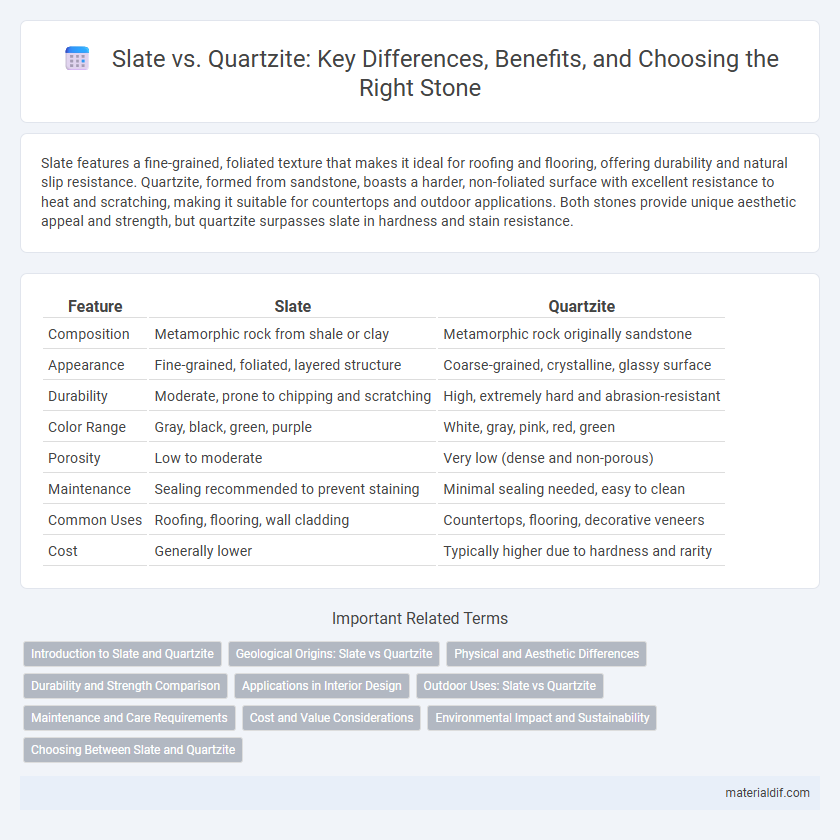Slate features a fine-grained, foliated texture that makes it ideal for roofing and flooring, offering durability and natural slip resistance. Quartzite, formed from sandstone, boasts a harder, non-foliated surface with excellent resistance to heat and scratching, making it suitable for countertops and outdoor applications. Both stones provide unique aesthetic appeal and strength, but quartzite surpasses slate in hardness and stain resistance.
Table of Comparison
| Feature | Slate | Quartzite |
|---|---|---|
| Composition | Metamorphic rock from shale or clay | Metamorphic rock originally sandstone |
| Appearance | Fine-grained, foliated, layered structure | Coarse-grained, crystalline, glassy surface |
| Durability | Moderate, prone to chipping and scratching | High, extremely hard and abrasion-resistant |
| Color Range | Gray, black, green, purple | White, gray, pink, red, green |
| Porosity | Low to moderate | Very low (dense and non-porous) |
| Maintenance | Sealing recommended to prevent staining | Minimal sealing needed, easy to clean |
| Common Uses | Roofing, flooring, wall cladding | Countertops, flooring, decorative veneers |
| Cost | Generally lower | Typically higher due to hardness and rarity |
Introduction to Slate and Quartzite
Slate is a fine-grained, foliated metamorphic rock derived from shale, known for its durability, resistance to moisture, and natural split cleavage, making it ideal for roofing, flooring, and outdoor applications. Quartzite forms from the metamorphism of quartz-rich sandstone, resulting in a highly dense, hard, and non-porous stone valued for its resistance to abrasion and elegant, glassy appearance. Both stones offer unique aesthetic and functional qualities, with slate exhibiting more layered textures and quartzite providing a smooth, glass-like finish suitable for interior and exterior design.
Geological Origins: Slate vs Quartzite
Slate forms from the low-grade metamorphism of shale, characterized by fine-grained foliated layers originating from compacted clay and volcanic ash. Quartzite develops through the high-grade metamorphism of pure quartz sandstone, creating an non-foliated, dense, and hard rock primarily composed of interlocking quartz grains. The distinct geological origins influence their physical properties, with slate exhibiting planar cleavage and quartzite demonstrating exceptional hardness and resistance to weathering.
Physical and Aesthetic Differences
Slate features fine-grained, foliated layers, making it naturally slip-resistant with a matte finish, while quartzite exhibits a harder, non-foliated crystalline structure that yields a glossy, glass-like surface. Physically, slate is softer and more prone to chipping but easier to split into thin slabs, whereas quartzite offers superior durability and resistance to scratches and heat. Aesthetically, slate showcases dark, earthy tones with subtle texture variations, contrasted by quartzite's vibrant, marble-like veining and brighter color range, enhancing its decorative appeal.
Durability and Strength Comparison
Slate offers excellent durability with its fine-grained structure and natural cleavage, making it resistant to cracking under pressure, while quartzite ranks higher in strength due to its metamorphic composition of quartz crystals tightly fused together. Quartzite exhibits superior hardness, scoring around 7 on the Mohs scale, compared to slate's softer 3.5-4, resulting in greater resistance to abrasion, impact, and weathering. This makes quartzite ideal for high-traffic surfaces and exterior applications, whereas slate is better suited for areas with moderate wear.
Applications in Interior Design
Slate offers excellent slip resistance and a natural, rustic aesthetic ideal for flooring, wall cladding, and bathroom interiors, while quartzite provides superior hardness and a high-gloss finish suitable for countertops, backsplashes, and high-traffic areas. Quartzite's durability and resistance to heat make it a preferred choice for kitchen surfaces, whereas slate's layered texture enhances cozy, traditional or industrial design themes. Both stones integrate well in modern and classic interiors, but quartzite's versatility and polishability expand its application in luxury design projects.
Outdoor Uses: Slate vs Quartzite
Slate offers excellent slip resistance and weather durability, making it ideal for outdoor patios, walkways, and pool surrounds. Quartzite boasts superior hardness and resistance to heat and abrasion, which is perfect for outdoor kitchen countertops and high-traffic garden paths. Both stones provide natural beauty and longevity, but quartzite's strength makes it more suitable for heavy-use outdoor applications.
Maintenance and Care Requirements
Slate requires minimal maintenance, needing only regular cleaning with mild soap and water to prevent staining and preserve its natural texture. Quartzite demands slightly more attention, as it must be sealed periodically to maintain its resistance to moisture and stains, especially in high-traffic areas. Both stones benefit from avoiding harsh chemicals and abrasive tools to extend their longevity and preserve their aesthetic appeal.
Cost and Value Considerations
Slate generally offers a lower cost per square foot compared to quartzite, making it a budget-friendly choice for flooring and countertops. Quartzite provides greater durability and a natural quartz composition, which can enhance property value through its premium aesthetic and long-lasting performance. Cost differences often reflect quartzite's higher resistance to scratching and heat, offering better long-term value despite the initial investment.
Environmental Impact and Sustainability
Slate is a natural metamorphic rock formed through low-grade regional metamorphism, making it highly durable with minimal processing requirements, which reduces its environmental footprint. Quartzite, derived from quartz-rich sandstone, undergoes intense metamorphism resulting in a hard, dense stone that requires more energy-intensive extraction and fabrication processes. While both stones are long-lasting and recyclable, slate's lower energy demand and smaller quarrying impact generally make it a more sustainable option compared to quartzite.
Choosing Between Slate and Quartzite
Slate offers excellent durability and a natural, textured appearance ideal for roofing and flooring applications, while quartzite provides superior hardness and resistance to abrasion, making it a preferred choice for countertops and high-traffic areas. When choosing between slate and quartzite, consider factors such as desired aesthetic, maintenance requirements, and project durability needs. Slate requires regular sealing to prevent water absorption, whereas quartzite's dense structure lowers maintenance efforts and enhances longevity in various environments.
Slate vs Quartzite Infographic

 materialdif.com
materialdif.com